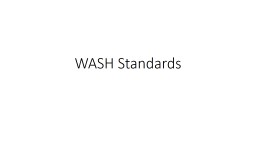

Safe and Adequate Water Sanitation Hygiene Pormotion Drainage Waste Management Phases of Response WASH response plan will be divided into 3 phases Phase 1 First 15 days for life saving response ID: 1020964
Download Presentation The PPT/PDF document "WASH Standards Emergency WASH Services/..." is the property of its rightful owner. Permission is granted to download and print the materials on this web site for personal, non-commercial use only, and to display it on your personal computer provided you do not modify the materials and that you retain all copyright notices contained in the materials. By downloading content from our website, you accept the terms of this agreement.
1. WASH Standards
2. Emergency WASH Services/StandardsSafe and Adequate Water:SanitationHygiene PormotionDrainageWaste Management.
3. Phases of ResponseWASH response plan will be divided into 3 phases. Phase 1: First 15 days for life saving responsePhase 2: 16 to 45 days Phase 3: 46 days up to 90 days. All interventions would be implemented based on immediate need and priority of the displaced population and standard timeframe will be established to deliver the life- saving intervention based on the ground reality.
4. Safe and Adequate Water:Responsibility: All Cluster members under KVWSMB/KUKL/MoUD leadershipObjective: To provide safe drinking water to affected populations (estimated 4.2 million people for 30 days) at 7 L/person/day initially and upgraded within one month to 15 L /person/day (for drinking, hygiene and cooking).Standard: See objective for quantity; accessibility, reliability and quality following Nepal Standard and Sphere standards on drinking water quality for emergencies
5. Sanitation StandardsImmediate excreta disposal options (designated defecation areas, trench latrines) - 1 week 1 toilet/50 people in 15-30 days; upgrade to 1 toilet/20 people (segregated by sex) after 1 month all in a package of hygiene promotion and incorporating gender/disability components Installation of urinals separate for male, female, children and disable people at larger camps Provided at each latrine: 1- 10 lit bucket, 1lit mug for anal cleansing and latrine cleaning kitMenstrual Hygiene Management system in place in female toilets1 bathing space for 5 H/Hs (segregated by sex, therefore 2 bathing per 10 households including 1 male and 1 female). Gender child and disable friendly bathing spaces WASH Cluster strategy:Agencies committing to construct temporary toilets and bathing facilities in camps to also make provisions for upgrading and repair, hygiene promotion and ensure handwashing facilities in each latrine site.
6. Hygiene PromotionTo build the capacity of the affected people to make them able and accountable to use and care the facilities/ services providedEnsure that camps are sufficiently clean so that the breeding of vector and spreading of the vector borne disease could be controlled.Raise hygiene awareness in close coordination with the health cluster and prevent, minimize and control the incidence of WASH related diseases in the vulnerable areas WASH Cluster Strategy:Capacity Building Use/mobilization of volunteersUse of local resourcesCoordination and networkingCommunity mobilizationGender and social inclusionInformation sharing and communication
7. Drainage , Solid Waste Management and Vector Control Responsibility: All Cluster members including DWSS/WSSDO in coordination with Municipalities and national NGOs e.g. ENPHOObjective: To provide adequate sanitation facilities and safe disposal of solid and liquid wastes for personal hygiene and vector controlStandards: Waste water disposal and solid waste management in campsVector control (flies and mosquitoes) in coordination with health clusterNo dwelling more than 100 m away from refuse container or pit
8. Overarching StrategyHumanitarian PrinciplesHuman Rights Based ApproachGender Equality and Social InclusionDisabilityRespect to local cultures and sentimentsCultural sensitivity Language Children, Adolescents, young people and oldDo no Harm Norms and Standards (consistency)Integrated approach and inter-agency collaborationCommunication for DevelopmentRisk Management and Assessment M&E, Accountability and Transparency
9. IndicatorsWater Supply SanitationHygieneWASH in SchoolsWASH in HCF# of affected people provided with sufficient quantity of water of appropriate quality for drinking, cooking and personal hygiene# of affected people who are provided with toilets and handwash facilities# of affected households that received a hygiene kit# of children accessing appropriate WASH facilities and hygiene education in temporary learning spaces, and other child-friendly spaces# of health care facilities provided with water supply, toilets, handwash facilities
10. Thank You!